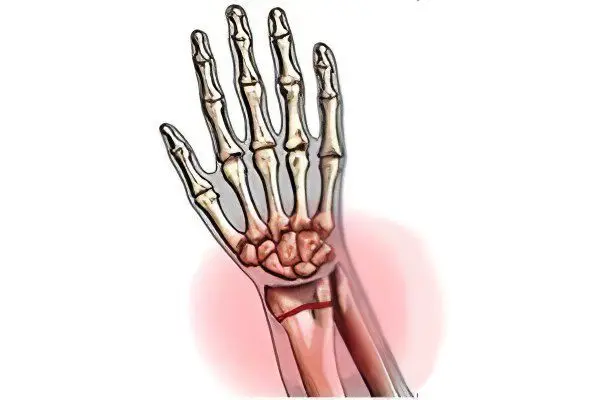Contents
A fall on an outstretched arm may well provoke a standard non-displaced wrist fracture in a person. This injury is quite common, especially in those people who lead an active lifestyle. Along with them, there are other types of fractures of the wrist, namely: with displacement and fracture of the radius. The first of these is a common type of fracture, in which there is a peripheral bone fragment towards the back of the wrist and thumb of the limb.
This injury is called a Colles fracture. Statistics indicate that a similar fracture of the wrist occurs in 27% of cases.
Symptoms of a Displaced Wrist Fracture

The signs of the described damage are quite obvious and they affect, first of all, in:
The occurrence of swelling in the area of the hand;
Visually noticeable deformation;
Feeling of sharp pain in the injured area, which increases when you try to move your fingers. Very often this syndrome makes even the slightest movement of the fingers impossible;
In some cases, the color of the brush changes to blue, which occurs due to internal hemorrhage in the soft tissue area.
Thus, any attempt to make any carpal movements, including minimal ones, turns out to be practically impossible for the victim, which should be considered an eloquent sign of damage. In order to clarify the diagnosis, it is necessary to carry out an x-ray.
In case of fractures of the hand with displacement, most often, it is advisable to take pictures in three projections at once. In more complex cases, their number may increase. If the above signs do not quite match what the victim feels, then this indicates that he only has a sprain of the ligaments of the hand or a standard bruise of the hand. These damages are easy enough to confuse without being a specialist. In order to preserve human health, it is recommended to exercise caution in the process of fixing the limb and minimize any attempts to move the hand. This will greatly facilitate further treatment.
Treatment of a displaced wrist fracture
After the patient has been admitted to the hospital and all the diagnostic methods necessary for a fracture of the hand with displacement have been applied, a course of treatment should begin. First of all, the so-called reposition of those parts of the bone that have undergone destruction is carried out. In the vast majority of cases, the procedure involves the use of anesthesia, and in more rare cases, surgery.
After the bones have been compared, the injured limb is immobilized. To do this, it is necessary to use a plaster cast until the brush and damaged bones themselves grow together.
To maintain immobility in the limb area, a variety of methods are used:
a plaster bandage or a special splint (these two methods can be used together and without surgery);
a metal plate with screws (you can not do without the operation);
standard screws that do not provide for any fixing elements (in this case, surgical intervention is also necessary).
If the victim has a high threshold of sensitivity to pain (especially for the elderly and children), then the process of treating a displaced wrist fracture will also involve the use of various painkillers. In most cases, this is limited to the use of drugs such as analgin or baralgin. In this case, it is necessary to take into account the individual characteristics of the organism.
In a plaster bandage or with any other fixing element, the victim can pass for a long time: from 8 to 11 weeks. After the plaster has been removed, it is mandatory to consider the implementation of a second x-ray. This will make sure that the bones are no longer displaced.
Rehabilitation and recovery after a broken wrist

As part of rehabilitation and recovery, it is necessary to carry out special exercises that:
will strengthen the muscles;
significantly increase the range of motion in the wrist.
In the case of a fused fracture of the hand with a displacement, it is necessary to seek the advice of a physiotherapist. It is he who will indicate the list of exercises, but it makes sense to do this only after the bones again receive a sufficient degree of strength. It is best to forget about playing sports for the next two or three months – until the wrist as a whole is fully strengthened.
A course of physiotherapeutic procedures will help speed up rehabilitation and recovery. Experts recommend signing up for a regenerating hand massage. This will enable all those ligaments and vessels that have “stagnated” to resume optimal functioning.
Exercise after a broken wrist
As noted above, as part of rehabilitation after a displaced fracture, regular exercises should be performed to help strengthen this area.
These include such as:
sparing flexion and extension of the injured hand in the joint itself;
basic lace tying.
It is also acceptable to throw a tennis ball that is not too large and hard, which cannot injure the hand, against the wall. In this case, it is advisable to carefully spread your fingers so that the blow is not so strong. In addition, it will not be superfluous to move an ordinary box of matches in your hand once a day for five to seven minutes. You should touch it along the edges without using the other hand at this time.
In the process of implementing the exercises presented, it is important to remember that their careful implementation will be the key to a quick recovery of the hand. Over time, it is recommended to increase the number of exercises until motor skills are normalized by 100%. Thus, a displaced fracture of the hand is characterized by quite obvious symptoms, and the process of treatment and recovery will be quite long.









